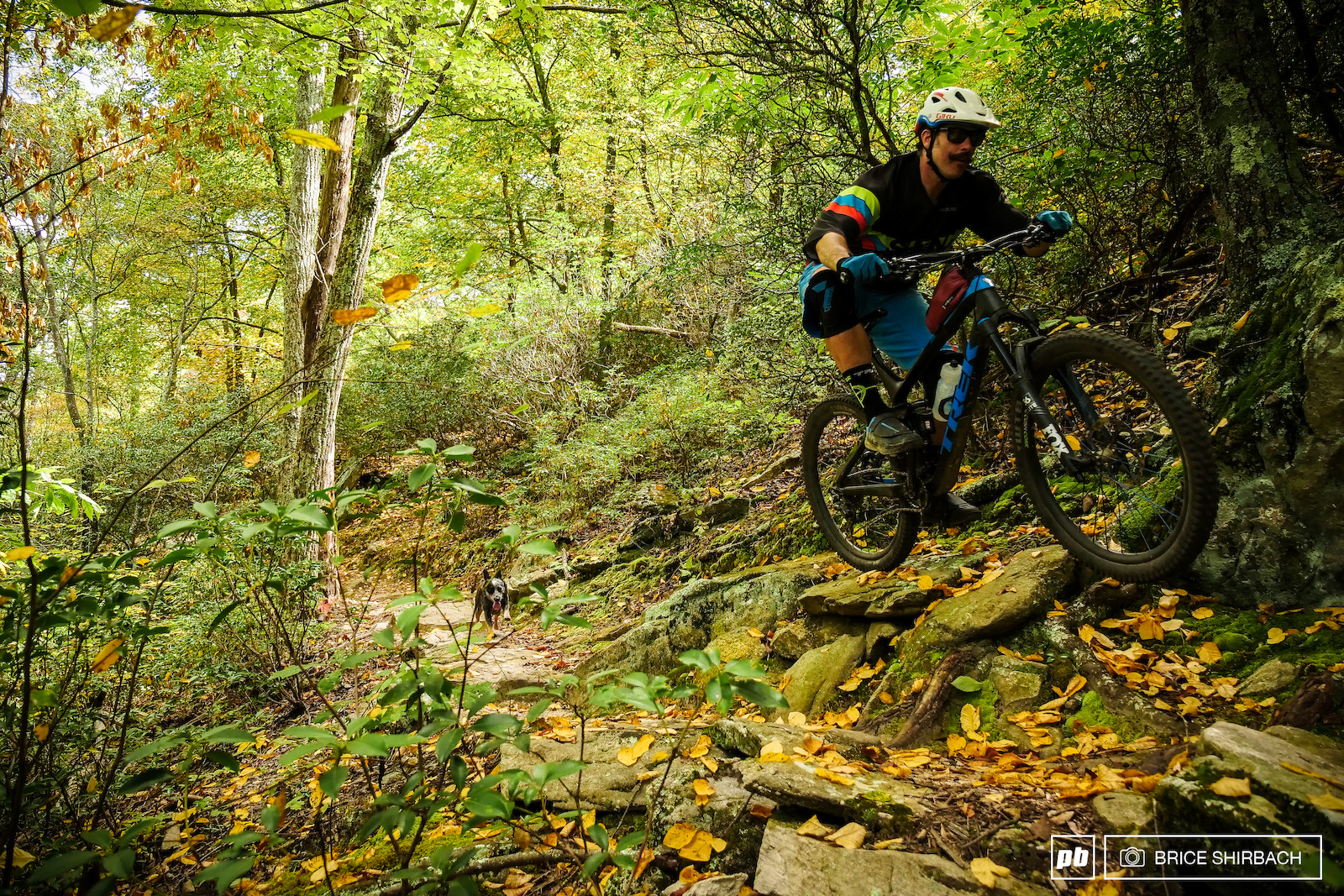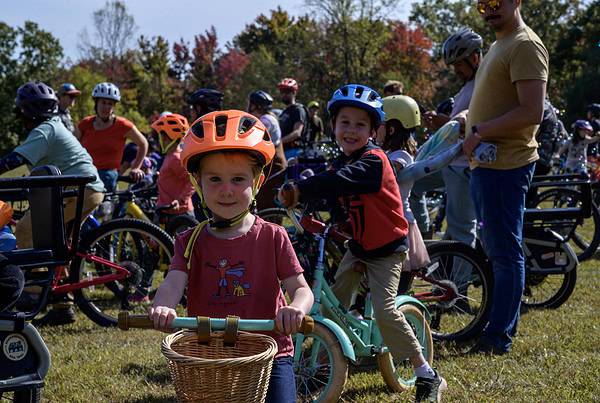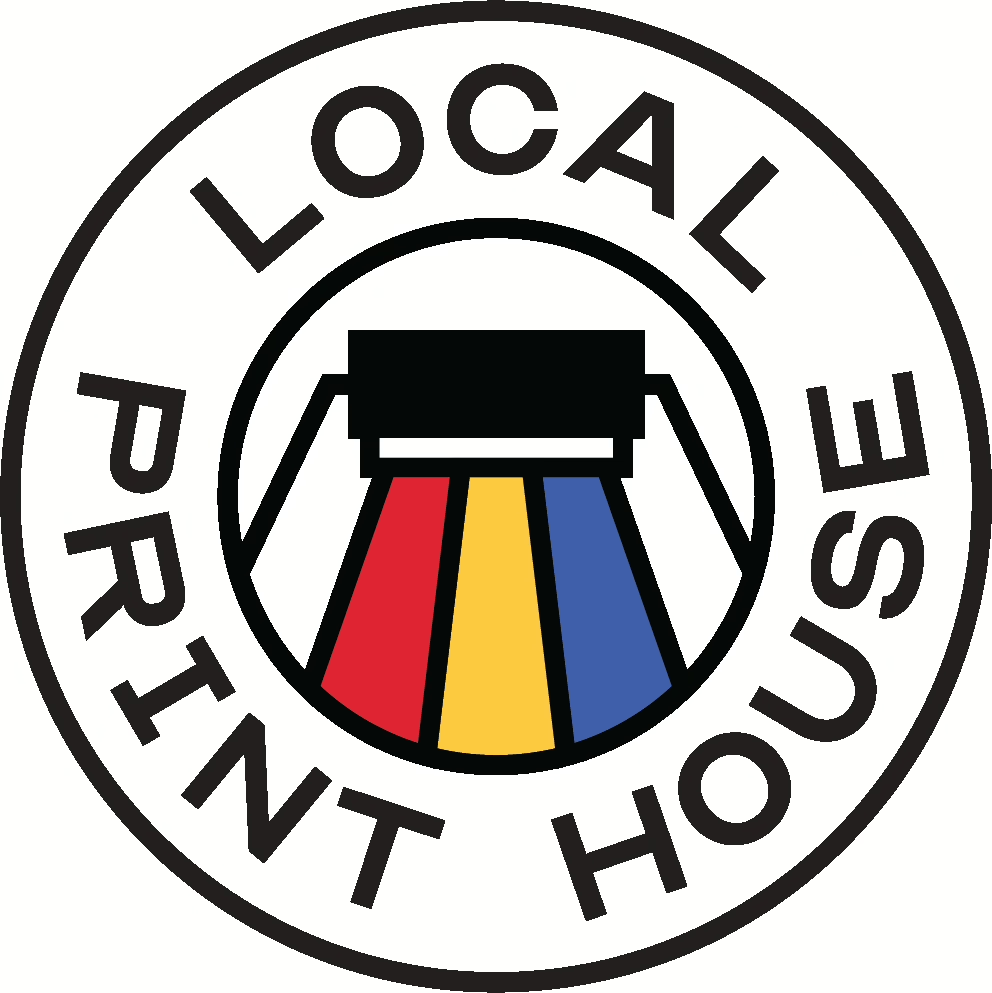As we wrap up 2022, we are asking for your support to help us Spread Pixie Dust in the Valley and ensure everyone has access to safe accessible biking and walking. Can you help us reach our 2022 Pixie Dust goals by midnight on December 31? Please consider a donation to the Coalition.
DonateOriginally appeared on Pink Bike: East Bound and Down: Harrisonburg, Virginia
Oct 12, 2017
There is an ever-evolving narrative in mountain biking that has me excited: communities looking to our sport and community as an economic and social asset. It’s a dynamic that we as mountain bikers should be proud of, as it’s often a reflection of the countless hours spent trail building, advocating, and meeting with land managers that have really given our community of mountain cyclists so much leverage throughout the country.
It’s a theme I have written about and witnessed for many years now, and places such as East Burke, Vermont; Roanoke, Virginia; and Davis, West Virginia are but a few of the growing list of towns on the east coast alone that look to their riders and trails for inspiration and economic growth. It’s a trend that I hope to see continue, as I love writing about these places and the critical thinkers who make them what they are today, and really enjoy the idea of a town “buying” in on mountain biking. Harrisonburg, Virginia, for the record, is not one of these places. The riding community that has been developed here isn’t the result of, or the stimulus behind the city’s growth. The town itself is doing just fine with or without bikes. No, Harrisonburg’s brilliant, and dynamic cycling opportunities are homegrown, and it’s one of my favorite things about this place.
When I am in planning mode for this series of stories, I like to break potential locations down into three categories: “under the radar”, “up and coming”, and “no brainer”. Harrisonburg has been a categorically “no brainer” location for East Bound & Down from the start. In fact, it’s one of those places where my confidence is so high in it’s ability to deliver the goods, I’ve made a concerted effort to seek out as many other locales as possible, instead of heading straight for the proverbial low hanging fruit.
However, I’m on Interstate 81 virtually every time I head south to ride, and more often than not, I drive right past the many Harrisonburg exits that occupy that long, straight, and dull highway. Massanutten stands as a jutting beacon of glory to the east. The vast backcountry peaks of the George Washington National Forest catch the eye to the west. It’s often difficult to justify the hours spent on that highway when I could just stop and play here. I fought. I resisted. I’ve had some incredible experiences well south of “The Valley”. In the end, though, I had to give in. This place is just unbeatable.


Harrisonburg’s population is just a touch over 53,000 strong, and is Travel and Leisure Magazine’s 6th favorite town in America.


The Friday night six-pack series runs from September through November, and celebrates some of the region’s best descents, in the company of some of its best people.
“The Burg” is located in the heart of the Shenandoah Valley, flanked to the east by Shenandoah National Park, and to the west by the absolutely massive George Washington National Forest. The city is home roughly 53,000 people, of which 20,000 are students at James Madison University. It’s a place I’ve long held near and dear to my heart, as much of my family comes from this part of the country. In fact, I was named after a nearby mountain resort about 40 miles to the north of town, which coincidentally, is now a bike park.
The mountain bike scene here is one of the oldest in the country, and has a long list of talented riders who call, or have called, this place home over the last few decades. When you get out on any of the hundreds of miles of trail here, the how’s and why’s of the technical proficiency, as well as the power and fitness of the local contingency, become immediately apparent. Outside of the Massanutten and Bryce bike parks, both of which are relatively new additions to the region, the thousands of feet of technical, picturesque, and legendary descending must first be climbed. Shuttling isn’t necessarily frowned upon, it is simply just not a part of the local lexicon. In recent years, trail systems have sprouted up in downtown at the Hillendale trail system, as well as on the western slopes of Massanutten, both of which provide quick access to riding that suits a wider range of mountain bikers. But Harrisonburg’s reputation was built by locals, for locals, and while its scene continues to grow and evolve, its origins remain intact and relevant even today.


Sandwiched between two massive ridgeline mountain ranges, the Shenandoah Valley has an abundance of fertile farmland, which helps explain why Harrisonburg and the rest of Rockingham County is the top agriculture-producing county in the state..


Shuttles aren’t the most common occurrence in these here parts, but I was grateful to not have to haul 30lbs of camera gear up Reddish, as our 10-mile descent alone took the better part of four hours.

West Virginia, along with some sort of secret government spy base, a.k.a. Sugar Grove Naval Base, loom in the distance. Some of the very best trails you’ll ever drop in on loom directly ahead.

This is just the start of an 11+ mile long descent. Not an inch of it is anything less than amazing.
“You don’t really know what you’re doing early on when it comes to the development of a mountain bike culture.” Chris Scott tells me from a swimming hole near the Stokesville Lodge and Campground. “There’s no end-game focus. Those of us who were a part of the community early on just wanted to figure out how we could get more folks out to ride. We came up with a “Dollar Downhill” idea, where we’d go around campus (James Madison), and place flyers on any somewhat nice looking bike we saw. We invited folks out to ride downhill with us. Everyone pitches in a dollar, and the winner takes all. It was awesome, and people really loved it. We added some trail work to the equation, and things along those lines, and it really helped us shape the community and bring people together.”
Chris is the owner of the aforementioned Stokesville Lodge, which in addition to being perhaps the most appropriately named mountain bike business…ever, is located just outside of Harrisonburg in, you guessed it, Stokesville, Virginia. Chris has long been one of the most influential figures in mountain biking on the east coast, and is responsible for more shenanigans and stories then we have room for on the internet, as well as some of the world’s most challenging endurance events including the Shenandoah Mountain 100, the Wilderness 101, and the Stoopid 50. He’s in his 20th year of running Shenandoah Mountain Touring, and his relatively new venture, the Stokesville operation, sits on the edge of the George Washington National Forest. Just outside of his door lies hundreds of miles of big mountain, backcountry adventure waiting for you. Chris came to Harrisonburg in the early nineties to be a part of what was then an emerging scene. While he’s had plenty of opportunities to travel around the world, racing and riding his bike all over Europe and North America, Harrisonburg and the surrounding area are too much a part of his DNA for him to consider calling anywhere else home.


Stokesville’s dreamy nature is the result of a lot of hard work from this man.


Chris Scott might call Harrisonburg home, but the respect for what he’s done for mountain biking is known around the world.


Sharing the forest isn’t an issue in this part of the country.

Shuttle or no, bring your climbing legs. There’s a reason Harrisonburg is or has been home to so many elite riders.

Kyle Lawrence wears many hats: father, husband, SVBC President, and commuter advocate are just a few. Oh yes, he’s also a pinner.
“The bike riding, the mountains, and the emergence of a scene brought me to Harrisonburg many years ago.” he says from the shores of the North River, which snakes its way through his property and the surrounding valley. “People like Mike Carpenter and Thomas Jenkins really shaped what has become a hotspot for riding on the east coast.”
We’re discussing the “early days” of the community here, and there’s a grin that comes with any story or recollection Chris shares with me during this discussion.
“I loved the feeling that would come with following a dotted line on a map, and going out in search of that specific trailhead. There’s nothing like surfing down a mountain for the very first time. You never really knew what was in store for you, there were no pictures of it, no blogs about the trail; you were kind of adventuring. We began to find trails that weren’t even on the map. I loved that sense of adventure.”

Harlan Price enjoys skipping stones.

This place rocks.


Reddish will leave you hankering for a sammy, and a cold one. Or two.

Near the top of Massanutten you’ll find this hang glider platform, which looks west over Harrisonburg, and Shenandoah Mountain. Rumors abound of flights reaching close to Philadelphia from this platform.

The western slopes of Massanutten offer a picturesque glimpse into the modestly stunning Appalachian countryside.

Scott Wootten is beloved by locals and visitors to the region alike. The Massanutten Bike Park lead supervisor and his pooch, Fflur, take a break from the lifts on the other side of the ridge and let ‘er rip down the “2,000 Hours” trail.
Chris isn’t alone in that sentiment. Thomas Jenkins has been living in Harrisonburg since the early 90’s. He’s the co-owner of the Shenandoah Bicycle Company, which opened its doors in 2000. He’s played several roles in his community, which includes co-founding the mountain bike club, which would eventually become the Shenandoah Valley Bicycle Coalition, a step he was an integral component to. He also sat on the Harrisonburg City Bicycle and Pedestrian Committee, as well as the JMU Bicycle and Pedestrian Committee. During my time in town, Thomas’ was typically the first name that would come up whenever the conversation went in the direction of people responsible for making Harrisonburg what it is today.
“It sends chills down my spine when I think back to this place in the early nineties.” Thomas tells me. We were talking at his shop before the doors opened for the day’s business. “Even the late eighties, when I first came to Harrisonburg to ride bikes. There weren’t many mountain bike scenes back in the late eighties, but I had a roommate who brought me up here to ride, and it opened my eyes to real mountain riding. I hadn’t seen it before. Bike riding was why I decided to move here in 1992. The people are really what caused me to stay.
It’s clear that Thomas and the rest of this community value the opportunities that have come from building a trusting and meaningful relationship with local land managers, including the National Forest Service. It might have been a nebulous and fuzzy arrangement early on, but this crew was quick to recognize the gold mine they were sitting on, and weren’t about to take that for granted.


Thomas’ roots go deep in these here parts. Some say that enduro even got its start here. The truth is somewhere in those notes.


Massanutten’s bike park offers up close to 1,100 vertical feet of classic, Virginia tech.

“All or Nutten” is the newest experts only trail from the top of the mountain, and has a decidedly raw and rowdy feel to it.

20 years ago, this pile of rocks made up the start for Massanutten World Cup downhill course.

If there was any roost to toss, Harlan Price would be throwing a few grenades into this corner.

A bit of flow towards the mid-mountain helps to break up the otherwise jackhammer tech that makes up most of the advanced riding here.
“In the early 90’s, it was all about exploring and building relationships.” Thomas notes. “Now, there’s certainly a lot more information available, but that wasn’t always the case. You used to have to pick people’s brains, or open up a poor quality map and go looking for trails. It was really huge to come across a trail with some friends, and we’d always say “Don’t tell anyone!”. You go to a party later, and someone is saying “Yeah, I heard about the new trail you guys found!”. Of course you couldn’t contain your excitement. Now, it’s now something we want to keep to ourselves. We love sharing it. We also love to share the community. We’re as much about the riding as we are about hanging out together. I want to see that continue to develop.
“Our riding opportunities have increased due to strong partnerships. Partnering with the city, and taking what was considered scrubbed woods and turning it into a really cool, in-town trail system. Our relationship with Massanutten has helped us develop the Western Slope trails from what was in the early nineties essentially off limits, to now this completely awesome trail system. The nearby resorts have seen our growth, and in turn have taken the opportunity to grow their own systems for some lift access riding. There’s still a very real backcountry experience here, and where I think most of the growth has occurred has been on what might be considered the front range. We want to create cyclists; people with a passion for riding bikes. I think one of the magical things about a bike is that you can connect with people that you might now have otherwise connected with.
“I don’t think that I was a part of the ‘first layer‘ of our mountain bike community here. There were people here before me discovering and exploring the trails on mountain bikes. We touched base with them. My generation of folks, myself, Chris Scott, Tim Richardson, Mike Carpenter, those are the people who were not just motivated to ride, but motivated to get stuff done. Now, Kyle is here and he’s a great leader for the community. I think the challenge now is trying to figure out how to build on what we’ve done up until this point.”


Lower on the mountain you’ll find plenty of fun, flowy options for those not looking to push their bikes and bodies to the limit.

Hopping on the lifts in the fall means sharing them with the leaf peepers here to take in some of the most beautiful foliage anywhere in the country.




There are three shops in the heart of downtown, and all of them work together to cultivate and build a strong cycling community, and often collaborate on projects and initiatives.


While the downtown area doesn’t have much in terms of lodging currently, the Stonewall Jackson B&B is within walking distance to loads of restaurants and attractions, has plenty of room for you and your bikes, with fast wi-fi, and of course, some mouth watering breakfasts to fuel your days of adventure.

The Shenandoah Valley boasts upwards of 300 miles of “Scenic Byway” roads, and some of them will take you directly into the heart of one of the east coast’s most fabled treasures, the George Washington National Forest.

These deep woods offer some incredible and challenging singletrack, and can take your breath away, literally and figuratively. n,b





